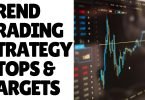What Is A Moving Average? https://financial-spread-betting.com/course/simple-moving-average.html Understanding Moving Average Settings
So, a moving average is very, very simple. You have different types of moving averages, in terms of sometimes, you have a simple moving average or an exponential moving average. They are very, very similar and you don’t need to get worried about them too much. The most important thing to know about a moving average is the length of the moving average determines how it is calculated. I have two moving averages loaded up on my chart here now.
What I am going to do is I am going to show you a couple of them. I have put on here a 20-period moving average, now what that is doing is that is showing me the average price over the last 20 periods. I have got a daily chart up here, don’t forget the period means whichever timeframe chart you have got loaded up, so I have a daily chart loaded up here and I have a 20-period moving average. This line here which is the blue line, lets thicken it up a little bit so we can see for this, nice thick blue line. That is plotting the average price for the last 20 days. You can see it basically lags price, but it just shows you, it just smooths out price. If you didn’t have a price on there at all you just get an average view and you don’t get to see the highs and lows, you just get to see how the market has ebbed and flowed over that day. That is a 20 period, if I was to move this to a 200 period, obviously, that is going to show me the average of the last 200 days, much smoother average. The higher number you go, the more days you are taking into account the smoother it is going to be. Then you can go right down to whatever you want, obviously, you can adjust it to whatever you want, a 5 period, which is going to give me really tight average of the past five days and there are some strategies we can use from that.
Generally speaking, people are going to use a 20 period, they are going to use 50 period and they are going to use 100 and 200, it just depends on what you are trying to achieve. Obviously then if you go down to let’s say a one minute chart you can still use the same thing and say you are using a 50 period as we are now, that is basically giving you the average price over the last 50 minutes or the price over the last ten minutes whatever you have that set at. It is multiplied by the timeframe setting you have got on your chart. Very useful for seeing just a general trend of the market and a lot of people like to look and see whether the price is above or below, some people have a strategy where they will sell if the price crosses below moving average and buy if a price crosses above it. Another way of doing it is to have two moving averages on your chart.
So, lets thicken this up a little bit, this one is a five but let’s make it a 10 and let’s make it a little bit thick so we can see it. You can see now, some people use several moving averages to judge, to filter out their trades, they might say for example okay we have got a 50-period moving average here on our one minute chart and we have got a 10-period moving average, I will buy when the price, when the small moving average (the 10-period) crosses above the 50-period and I will sell when the moving average crosses back below. You can see that if you had done that then in this random example we just picked up here you are going to belong from this point here and then you are going to exit at this point here and if you were doing it strictly maybe you would go short as we broke under it and you would cover it as we broke up through it, so now you are getting to a point where you may be taking a trade right this instance. That is what a lot of people do, it is called a moving average crossover system and a lot of people do look at that.






